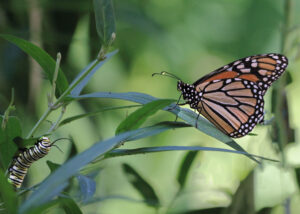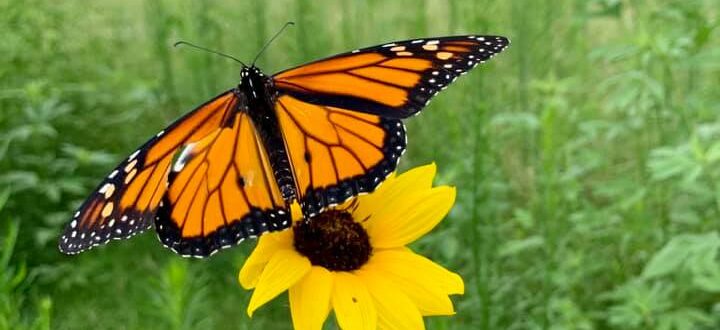On December 15, 2020, the U.S. Fish and Wildlife Service (USFWS) announced that it finds Endangered Species Act listing for the monarch butterfly WARRANTED BUT PRECLUDED.
There were three potential outcomes for the ESA listing decision for the monarch butterfly. The third option was announced by the USFWS on December 15, 2020.
- Listing is warranted.
- Listing is not warranted.
- Listing is warranted, but precluded by other higher priority species.
What does this finding mean?
It means that monarch butterflies are now a candidate species. Each year, their status will be re-evaluated for potential listing. Candidate species do not have legal protections under the ESA, but this status highlights the need for continued monitoring and voluntary conservation efforts.
From the USFWS:
After a thorough assessment of the monarch butterfly’s status, the U.S. Fish and Wildlife Service (Service) has found that adding the monarch butterfly to the list of threatened and endangered species is warranted but precluded by work on higher-priority listing actions. With this decision, the monarch becomes a candidate for listing under the Endangered Species Act (ESA), and its status will be reviewed each year until it is no longer a candidate.
“We conducted an intensive, thorough review using a rigorous, transparent science-based process and found that the monarch meets listing criteria under the Endangered Species Act. However, before we can propose listing, we must focus resources on our higher-priority listing actions,” said U.S. Fish and Wildlife Service Director Aurelia Skipwith. “While this work goes on, we are committed to our ongoing efforts with partners to conserve the monarch and its habitat at the local, regional and national levels. Our conservation goal is to improve monarch populations, and we encourage everyone to join the effort.”
After a thorough review of the best available scientific and commercial information, the Service found that listing the monarch butterfly as an endangered or threatened species is warranted but precluded by higher priority actions to amend the Lists of Endangered and Threatened Wildlife and Plants. Therefore, the Service is adding the monarch butterfly to the candidate list and assigning it a listing priority number of eight. This priority number indicates the magnitude of threats is moderate and those threats are imminent.
The ESA provides for a warranted-but-precluded finding when the Service does not have enough resources to complete the listing process because the agency must first focus on higher-priority listing rules. Warranted-but-precluded findings require subsequent review each year until the agency undertakes a proposal or makes a not-warranted finding.
Read the full USFWS announcement.
ADDITIONAL RESOURCES
- Questions and Answers: 12-month finding on a petition to list the monarch butterfly
- Species Status Assessment Report (5.5 MB PDF)
- Species Assessment and Listing Priority Assignment Form (1.2 MB PDF)
- 12-month finding presentation (1.6 MB PDF)
- Monarch Conservation Database
- Monarch petition and 90-day finding
- Species status assessment framework fact sheet (PDF)
The USFWS defines an endangered species as “in danger of extinction throughout all or a significant portion of its range” and a threatened species as “likely to become endangered in the foreseeable future throughout all or a significant portion of its range.” Read more about this distinction.
The ESA was signed into law in 1973. Over the past 47 years, this legislation has provided protections for hundreds of species nearing extinction. Regardless of the upcoming ESA listing decision for the monarch butterfly, the ESA is incredibly important to conservation. Learn more in this video created by the USFWS on the 40th anniversary of the ESA.
Monarch Conservation is important! Here are just a few reasons why:
 Monarch habitat is shared with countless other organisms, including native bees and other pollinators.
Monarch habitat is shared with countless other organisms, including native bees and other pollinators.- Other species that have experienced drastic declines also benefit from monarch conservation actions.
- Proactive conservation and a holistic approach to conserving diverse grassland habitats will mitigate the decline of other species that may be in need of Endangered Species Act protections.
As we continue our efforts to save the monarch butterflies, let’s celebrate some recent milestones in Monarch conservation:
- 2014: A petition was issued to the U.S. Fish and Wildlife Service to consider monarchs for listing under the ESA.
- 2014: A U.S. Presidential Memorandum included provisions specifically for monarch butterflies.
- 2015: The U.S. government published a National Strategy to Promote the Health of Honey Bees and Other Pollinators that affirmed the commitment of federal agencies to monarch conservation.
- 2016: A Monarch Butterfly Conference Report under ESA’s section 7 was released as a proactive measure to aid the NRCS, in agreement with the USFWS, in implementing certain Farm Bill conservation practices for monarch butterflies.
- 2017: Key research milestones were published through efforts of the Monarch Conservation Science Partnership that were critical in informing conservation strategies and targets.
- 2018: The Oklahoma Monarch & Pollinator Collaborative launched the a Statewide Monarch Conservation Plan which includes the Okies for Monarchs outreach campaign.
- 2018: The Mid-America Monarch Conservation Strategy was released (MAFWA).
- 2019: The Western Monarch Butterfly Conservation Plan was released (WAFWA).
- 2019: The Nationwide Candidate Conservation Agreement for Monarch Butterfly on Energy and Transportation Lands was released.
- 2019: Okies for Monarchs released a guide for Best Management Practices for the Monarch Butterfly in Oklahoma Rangelands.
- 2020: Since the launch of Okies for Monarchs:
- 3,375 Oklahomans have taken the pledge to help save the monarchs
- 565 residents, organizations and businesses have planted Monarch Waystations
- 516 farmers and ranchers pledged to plant at least 250 sq. ft. of pollinator habitat
- 229 Oklahomans have registered their pollinator habitat and educational projects with Okies for Monarchs.
Monarch conservation must continue to move forward through collaborative efforts like these.
Here are a few ways you can get involved:
- Take the Pledge to Help Save the Monarchs
- Create Pollinator Habitat → What to Plant
- Register Your Pollinator Project
- Certify Your Garden
- Get involved with community science in your area
- Spread awareness about monarch declines and conservation opportunities
Conserving monarch butterflies is part of a larger strategy to protect our planet’s biodiversity. The ESA is vitally important legislation that helps us protect threatened and endangered species in the U.S. However, our conservation strategy will be most effective if it includes proactive protections for all wildlife. Recovering America’s Wildlife Act is a bipartisan effort to provide funding for proactive wildlife conservation measures. Learn more and show your support for this bill.


